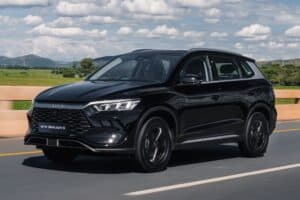Improvements aplenty but one big tweak needs to be made.

What is in the meaning of a name? It is a question every automaker surely asks when rolling out a new model. Get it right and it will last in the memory banks for years, but get it wrong and the results are well, ask Mitsubishi (Pajero), Hyundai (Creta), Isuzu (Mysterious Utility Wizard), Ford (Probe) and Honda (That’s) for example.
On the face of this, Jeep’s opting for the Compass nomenclature back in 2006 didn’t evoke any rude comments or snickering as it fitted in rather well with the brand’s military heritage. That is until the order was given for it and next step-up Patriot to head into battle.
Until the arrival of the Renegade, both copped significant flak for being everything a Jeep shouldn’t be by being primarily soft-roaders aimed at city dwellers rather than Rubicon conquering gladiators. Although the Patriot’s duty came to an end five years ago, the Compass remained on the battlefield and during the same year, had the chance to make amends when FCA revealed the less puffer-fish looking second generation at the Los Angeles International Auto Show.
As well as replacing the Patriot, the Compass looked more the mini Grand Cherokee its bloated predecessor never did, and despite being based on a development of the Renegade’s platform, it had a low range gearbox, the option of four-wheel-drive and selectable driving modes. It therefore asked the question: Has Jeep finally found the Compass’ true North at the second attempt?
The question remained unanswered as FCA South Africa waited until 2018 but even then, the Compass’ introduction was more akin to a secret mission as it landed with no fanfare. You can imagine this writer’s unexpected surprise then when the Compass showed up for duty towards the end of last year in its Trailhawk regalia against the back of a stunning Hydro Blue uniform.
Fresh from a mid-life earlier this month, which is a no-no for South Africa for now, the Compass still looks imposing in typical Jeep fashion thanks to the trademark seven-slot grille’s black surrounds, the attractive 17-inch diamond-cut alloy wheels and those clue providing red tow hooks on either side of the lower air intake.
As well as the black cladding around the wheel arches, at the base of the doors and those menacing headlights, the Compass not only looks macho but also upmarket and seemingly capable of taking on the trail that has resulted in it receiving the red-and-chrome badge on the front wings with ease
Inside, matters are less impressive as the layout and design are starting to show their age. Against the backdrop of the dark and cheap feeling plastics, in spite of the mood being lifted a bit by the red accents, the Trailhawk boasts an 8.4-inch Uconnect touchscreen infotainment system with Apple CarPlay, Android Auto and satellite navigation. Not the easiest to use, it does hide a few Easter Eggs though in the choice of the backgrounds, which in this case was an attacking hawk similar to the logo on the bootlid.
The rest of cabin is logically laid out with the switches for the dual-zone climate control feeling chunky and the Selec-Terrain mode selector in front of the gear lever providing a clear indication of the setting selected. An annoyance though was the seven-inch TFT instrument cluster which would automatically assume that the Compass was about to be parked when coming to a stop, and show the Park Assist display that would only disappear by forward movement or being switched off via the infotainment system.
In terms of spec, the R604 705 Trailhawk comes fully loaded with items such as a dual-pane panoramic roof, an impressive nine-speaker BeatsAudio sound system, ventilated front seats with the driver’s chair being electric, rain sense wipers and lights, Lane Departure Warning, Forward Collision Warning, Adaptive Cruise Control and Rear Cross Traffic Alert. Behind the electric tailgate is a 438-litre boot.
Sadly, the Compass goes off course when you get moving. Unlike in India where the South African models are sourced form, the Trailhawk loses out on the 2.0 Multijet turbodiesel engine and opts for the normally aspirated 2.4-litre Tigershark petrol US models have. In spite of being named after what is viewed as one of the most ferocious shark species on earth, the engine is too reluctant to bite.
Producing an underwhelming 129kW/227Nm, the 1 623 kg Compass initially reacts with verve but loses grunt and becomes sluggish as it simply doesn’t have enough torque. The drivetrain’s biggest issue though is the nine-speed automatic gearbox which is not only slow, but oddly ratioed and seemingly incapable of selecting the top two gears at the national limit. More inclined to stay in seventh and drop two or three gears when downshifting, the ‘box does become a bit slicker in manual mode, but not by much.
Venturing off-road, the Compass felt out of place despite the course being easy in addition to its 216 mm ground clearance, Hill Descent Control, all-terrain tyres and all of the mentioned off-road hardware. While not bottoming out or scraping, it still couldn’t get up an otherwise easy rocky slope despite being in Rock mode and with low range engaged, although in its defence, it could have been as a result of its driver being too cautious. As for fuel consumption, the weeklong stay resulted in an indicated best of ten-litres/100 km.
As much as Jeep has recalibrated the Compass from what it was, the process went horribly wrong with the drivetrain. In effect, it spoils what is a good looking, very well equipped and decent riding SUV that can go off-road much further than any comparative rival. Here is hoping then that the facelift, when does become available, finally allows the Compass to find its true North.
For more news your way, download The Citizen’s app for iOS and Android.












